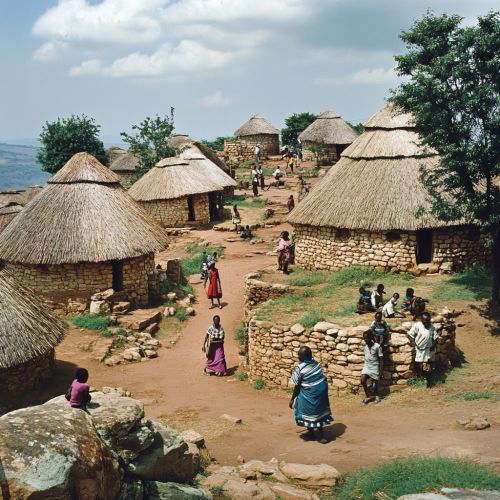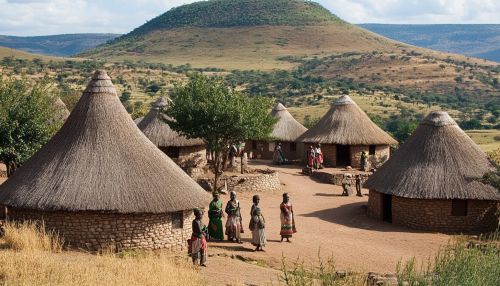Sotho: Difference between revisions
(Created page with "== Introduction == The term "Sotho" refers to a group of closely related Bantu languages and the people who speak them, primarily located in Southern Africa. The Sotho languages are part of the larger Niger-Congo language family and are predominantly spoken in Lesotho, South Africa, and Botswana. The Sotho people are divided into three main groups: the Southern Sotho (Basotho), the Northern Sotho (Bapedi), and the Western Sotho (Batswana), each with distinct cultural an...") |
No edit summary |
||
| Line 31: | Line 31: | ||
Sotho art and craft are renowned for their intricate designs and functional beauty. Traditional crafts include pottery, weaving, and beadwork, often used in everyday life and ceremonial contexts. The Basotho are particularly famous for their distinctive Basotho blankets, which are both practical and symbolic. | Sotho art and craft are renowned for their intricate designs and functional beauty. Traditional crafts include pottery, weaving, and beadwork, often used in everyday life and ceremonial contexts. The Basotho are particularly famous for their distinctive Basotho blankets, which are both practical and symbolic. | ||
[[Image:Detail-98451.jpg|thumb|center|Traditional Sotho village with thatched huts and people in traditional attire.|class=only_on_mobile]] | |||
[[Image:Detail-98452.jpg|thumb|center|Traditional Sotho village with thatched huts and people in traditional attire.|class=only_on_desktop]] | |||
== Historical Context == | == Historical Context == | ||
Latest revision as of 09:23, 12 October 2024
Introduction
The term "Sotho" refers to a group of closely related Bantu languages and the people who speak them, primarily located in Southern Africa. The Sotho languages are part of the larger Niger-Congo language family and are predominantly spoken in Lesotho, South Africa, and Botswana. The Sotho people are divided into three main groups: the Southern Sotho (Basotho), the Northern Sotho (Bapedi), and the Western Sotho (Batswana), each with distinct cultural and linguistic characteristics.
Linguistic Characteristics
The Sotho languages are part of the Sotho-Tswana branch of the Bantu languages. They are characterized by their use of noun classes, a complex system of prefixes and suffixes that modify nouns to convey grammatical information such as number, gender, and case. The languages also employ a system of concords, which ensure agreement between different parts of a sentence.
Phonology
Sotho languages exhibit a rich phonological system, including a variety of vowel and consonant sounds. They are tonal languages, meaning that pitch is used to distinguish between words that are otherwise phonetically identical. Common phonetic features include the use of click sounds, which are a distinctive characteristic of many Southern African languages.
Grammar
The grammar of Sotho languages is agglutinative, meaning that words are formed by stringing together morphemes, each contributing a specific meaning. Verbs are highly inflected, with prefixes and suffixes indicating tense, aspect, mood, and subject agreement. Noun classes play a crucial role in the grammar, affecting verb conjugation and adjective agreement.
Cultural Aspects
The Sotho people have a rich cultural heritage that is reflected in their languages, traditions, and social structures. Each subgroup of the Sotho people has unique cultural practices, but they also share common elements that bind them together.
Social Structure
Traditional Sotho society is organized into clans, each led by a chief. The chieftaincy system is an integral part of Sotho culture, with chiefs playing significant roles in governance, conflict resolution, and cultural preservation. The social structure is patriarchal, with lineage traced through the male line.
Traditional Practices
Sotho cultural practices include initiation rites, which mark the transition from childhood to adulthood. These rites involve seclusion, education in cultural norms, and ceremonies that culminate in the initiation of young men and women into adult society. Traditional music and dance are also important cultural expressions, often performed during ceremonies and festivals.
Art and Craft
Sotho art and craft are renowned for their intricate designs and functional beauty. Traditional crafts include pottery, weaving, and beadwork, often used in everyday life and ceremonial contexts. The Basotho are particularly famous for their distinctive Basotho blankets, which are both practical and symbolic.


Historical Context
The history of the Sotho people is marked by migration, conflict, and adaptation. The Sotho-Tswana peoples are believed to have migrated southward from the Great Lakes region of East Africa, settling in the highlands of Southern Africa.
Pre-Colonial Period
Before the arrival of European colonizers, the Sotho people lived in autonomous chiefdoms, with economies based on agriculture and cattle herding. They engaged in trade with neighboring groups and developed complex social and political systems.
Colonial Era
The arrival of European settlers in the 19th century brought significant changes to Sotho society. The Basotho, under the leadership of King Moshoeshoe I, resisted colonial encroachment and established the Kingdom of Lesotho. The Northern and Western Sotho were incorporated into the British colonies of South Africa and Botswana, respectively.
Post-Colonial Developments
In the post-colonial era, the Sotho people have navigated the challenges of modernization, globalization, and political change. Lesotho gained independence from Britain in 1966, while the Sotho people in South Africa and Botswana have become integral parts of their respective nations.
Sotho Languages in Modern Times
Today, the Sotho languages are spoken by millions of people across Southern Africa. They are recognized as official languages in Lesotho and South Africa, where they are used in education, media, and government.
Language Preservation
Efforts to preserve and promote Sotho languages include the development of educational materials, literature, and media content in these languages. Language preservation is seen as crucial for maintaining cultural identity and heritage.
Challenges and Opportunities
The Sotho languages face challenges such as the dominance of English and other global languages, which can lead to language shift and loss. However, there are also opportunities for revitalization through technology, cultural initiatives, and policy support.
Conclusion
The Sotho people and their languages represent a vital part of Southern Africa's cultural and linguistic diversity. Understanding the complexities of Sotho languages and cultures provides insight into the broader dynamics of African societies and their interactions with global forces.
